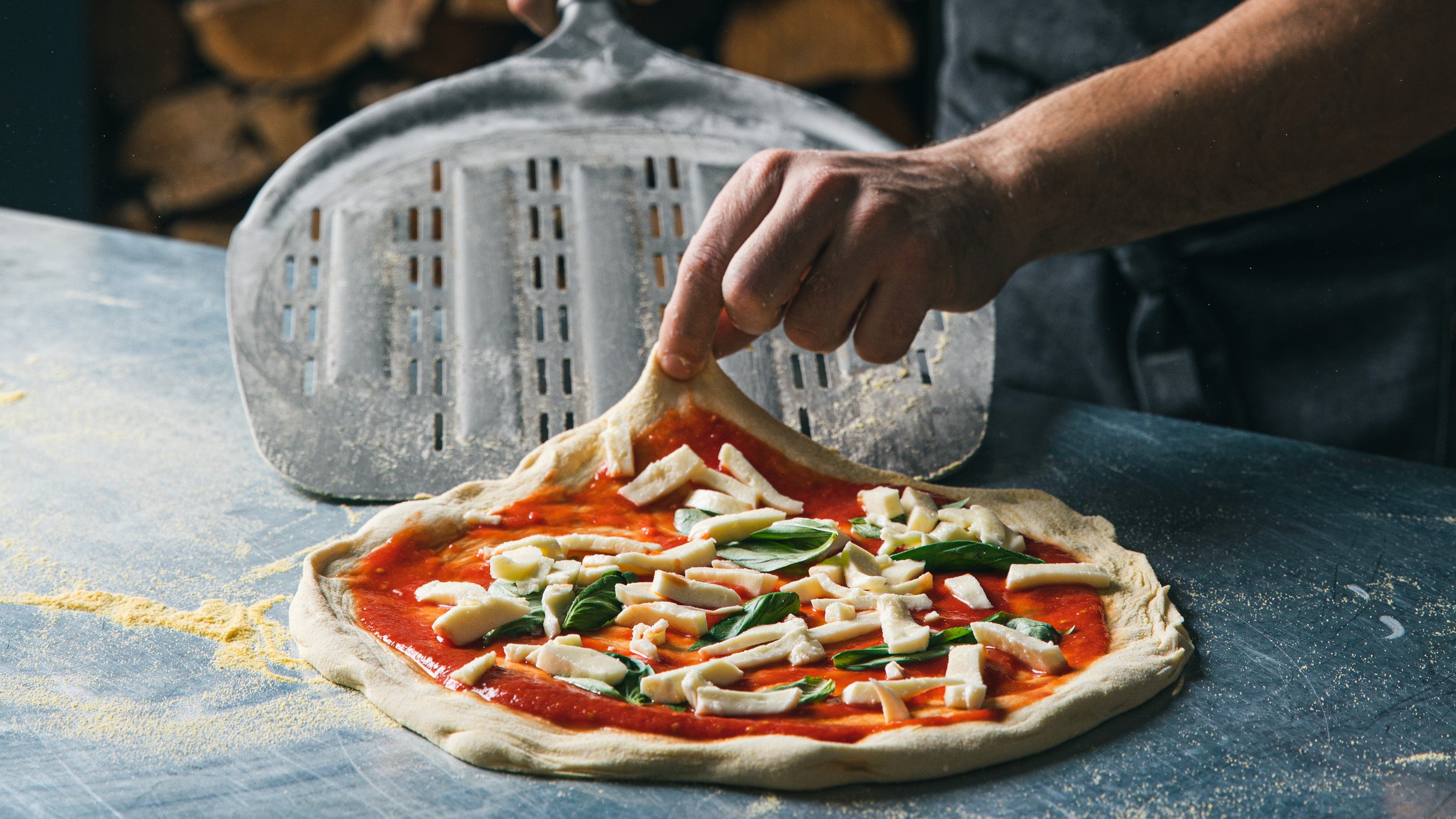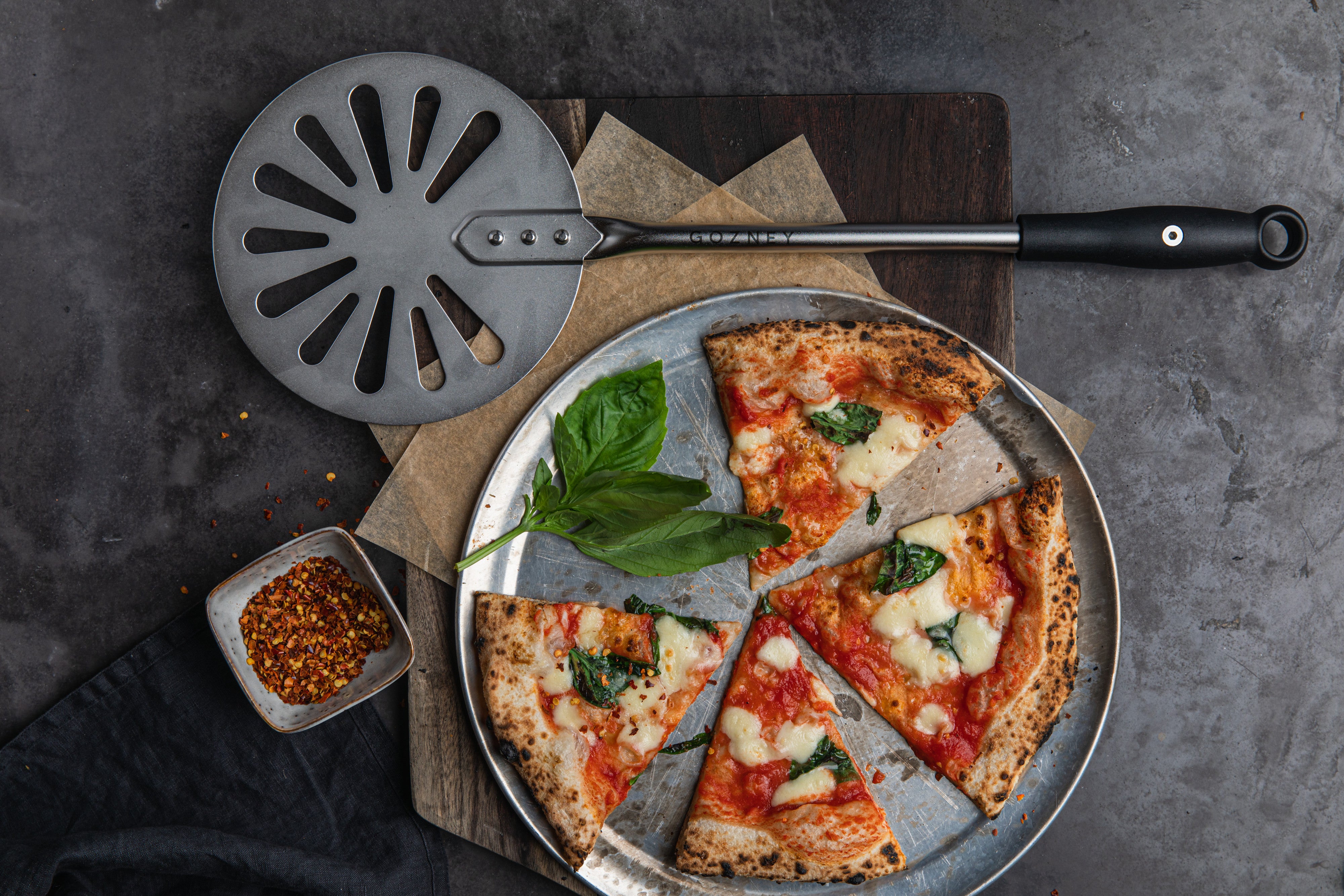Pizza peels come in all shapes and sizes - but what exactly is a pizza peel? And do you absolutely have to have one to get the best out of your outdoor pizza oven? We asked Gozney chef Joe Boiling to talk us through the different types of peels and how to get the best out of them and why we absolutely need pizza peels in our lives…
If I set you a challenge of successfully getting a beautifully opened and topped pizza from your work surface to a 900 degree oven what would you do?
You’d almost certainly use a pizza peel… I guess you could try throwing it in the oven like a frisbee but speaking from experience this is messy and dangerous in equal measure. And that’s why you need a pizza peel.
Before we talk about the different types of peels and their uses let’s talk about the elephant in the room shall we… Why on earth is it called a peel?!
A valid question and disappointingly not from the fact that pizza is soo a-peel-ing (sorry) but it actually derives from the latin word pala which means shovel or spade. So if you prefer to call it a shovel or spade you’re not technically wrong (and you can tell that to the pizza snobs that correct you on that!).
And really it makes a lot of sense that the word would be that old as although we colloquially refer to it as a ‘pizza’ peel, peels of some sort pre-date the wonderful invention of pizza (would have sucked living back then wouldn’t it?!).
Although pizza was yet to be born, medieval folk and even Egyptians would use something very similar to what we would now recognise as a pizza peel to bake some of the earliest breads.
But we digress… Nowadays pizza peels come in a variety of shapes and sizes with certain peels better suited to particular jobs, so let’s take a look at them...

A PLACEMENT PEEL
A placement peel (sometimes called a landing peel) is a vital piece of equipment when making pizza. I’ve heard nightmare stories of something happening to a chef’s placement peels mid service and spatulas, small turning peels and even bent teaspoons have been utilised in an attempt to bake the last few pies but really, it's a necessity.
Pizzerias will generally have more than one of these (to avoid the situation mentioned above) and it’s important they are kept clean, cool and free of debris to make sure our pizzas slide in without any mishaps.
Made of wood or metal, a placement peel is the peel with the biggest head that is used to slide your pizza into your screaming hot oven. Some people bake pizzas on screens and certain styles (Detroit etc) are baked in pans, but for the majority of wood fired pizzas we want the dough to come into direct contact with the hot floor, which is why you’re aiming to whip out the turning peel and leave the pizza in the oven - just like the tablecloth trick when all the glasses stay where they are!
Although some of the more traditional peels are made of wood, more modern pizza peels are made from metal like the Gozney Placement Peel and the shorter handled Roccbox Peel which are made from aluminium with a hard anodized finish.
The Gozney peels also have perforated gaps to allow excess flour to fall through (too much flour can burn the base) and are made to commercial standards. You can learn more about using a placement peel with our video on How To Use A Pizza Peel here.

TURNING PEELS
Whether you're baking with a flame at the back of the oven as with Roccbox or to the side as with Dome and Gozney’s larger ovens, your pizza will need to be rotated to bake evenly.
You can use a placement peel for this of course, by scoping the pizza onto the placement peel and carefully bringing it to the mouth of the oven to turn with your fingers quickly before returning the pizza to the oven. For a smaller oven such as Roccbox this can work fine as your pizza is always going to be close to the mouth of the oven when you turn it.
But for larger ovens, it’s impractical to work this way (and it burns your fingers!) and a turning peel is the solution.
As with the placement peels, Gozney offers a smaller handled Roccbox Turning Peel and a larger handled Gozney Turning Peel for use with any size outdoor pizza oven. But if the turning peel isn’t ‘essential’ like the placement peel, do you really need one?
Well, yes, for the larger ovens and yes ideally for the Roccbox.
The turning peel allows you to keep your pizza in the oven for the entirety of the bake meaning an even rise and bake in the crust. You’re also less likely to burn your pizza base as you are able to rotate the pizza on the same spot of the floor (once your skills are there!) and a turning peel also makes it easy to lift the base of the pizza and check the bake regularly.
Most pizzaiolos will also use a turning peel for removing the pizza from the oven too as, unlike the placement peel, you don’t need to keep the turning peel clean and cold as you’re not going to be sliding uncooked dough onto it.
If you find it easier to remove the pizza with a placement peel you can, but then you need it to cool down before you can put another pizza in. You can check out this video on How To Use A Turning Peel or a foolproof guide to getting the most out of your turning peel and then you can keep your placement peel clean and ready to go for the next pie!

As with most things pizza, ‘practice makes perfect’ but your pizza game will seriously level up once you master how to use both peels properly - happy pizza making!









